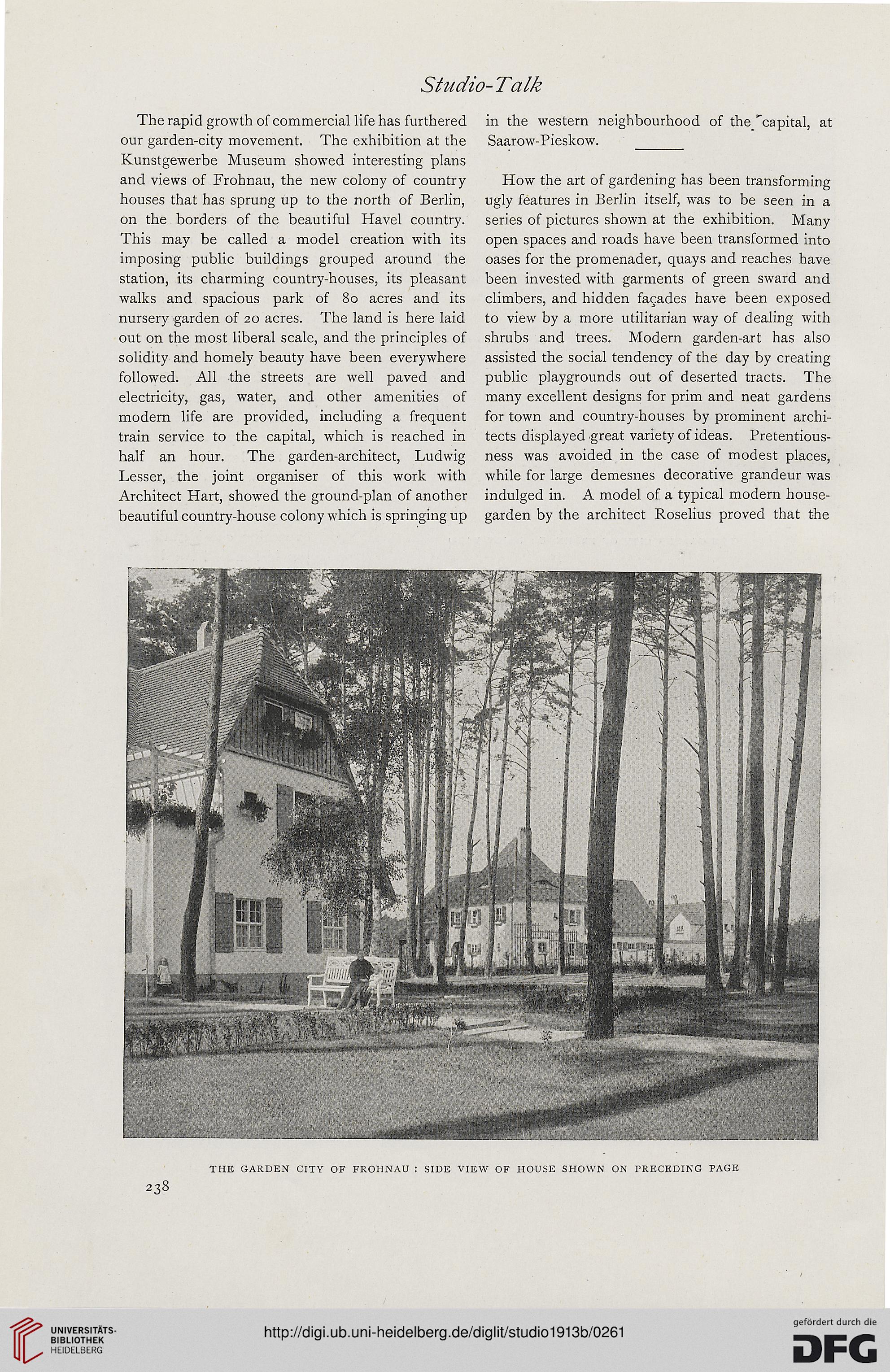Studio-Talk
The rapid growth of commercial life has furthered
our garden-city movement. The exhibition at the
Kunstgewerbe Museum showed interesting plans
and views of Frohnau, the new colony of country
houses that has sprung up to the north of Berlin,
on the borders of the beautiful Havel country.
This may be called a model creation with its
imposing public buildings grouped around the
station, its charming country-houses, its pleasant
walks and spacious park of 80 acres and its
nursery garden of 20 acres. The land is here laid
out on the most liberal scale, and the principles of
solidity and homely beauty have been everywhere
followed. All the streets are well paved and
electricity, gas, water, and other amenities of
modern life are provided, including a frequent
train service to the capital, which is reached in
half an hour. The garden-architect, Ludwig
Lesser, the joint organiser of this work with
Architect Hart, showed the ground-plan of another
beautiful country-house colony which is springing up
in the western neighbourhood of the "capital, at
Saarow-Pieskow.
How the art of gardening has been transforming
ugly features in Berlin itself, was to be seen in a
series of pictures shown at the exhibition. Many
open spaces and roads have been transformed into
oases for the promenader, quays and reaches have
been invested with garments of green sward and
climbers, and hidden facades have been exposed
to view by a more utilitarian way of dealing with
shrubs and trees. Modern garden-art has also
assisted the social tendency of the day by creating
public playgrounds out of deserted tracts. The
many excellent designs for prim and neat gardens
for town and country-houses by prominent archi-
tects displayed great variety of ideas. Pretentious-
ness was avoided in the case of modest places,
while for large demesnes decorative grandeur was
indulged in. A model of a typical modern house-
garden by the architect Roselius proved that the
The rapid growth of commercial life has furthered
our garden-city movement. The exhibition at the
Kunstgewerbe Museum showed interesting plans
and views of Frohnau, the new colony of country
houses that has sprung up to the north of Berlin,
on the borders of the beautiful Havel country.
This may be called a model creation with its
imposing public buildings grouped around the
station, its charming country-houses, its pleasant
walks and spacious park of 80 acres and its
nursery garden of 20 acres. The land is here laid
out on the most liberal scale, and the principles of
solidity and homely beauty have been everywhere
followed. All the streets are well paved and
electricity, gas, water, and other amenities of
modern life are provided, including a frequent
train service to the capital, which is reached in
half an hour. The garden-architect, Ludwig
Lesser, the joint organiser of this work with
Architect Hart, showed the ground-plan of another
beautiful country-house colony which is springing up
in the western neighbourhood of the "capital, at
Saarow-Pieskow.
How the art of gardening has been transforming
ugly features in Berlin itself, was to be seen in a
series of pictures shown at the exhibition. Many
open spaces and roads have been transformed into
oases for the promenader, quays and reaches have
been invested with garments of green sward and
climbers, and hidden facades have been exposed
to view by a more utilitarian way of dealing with
shrubs and trees. Modern garden-art has also
assisted the social tendency of the day by creating
public playgrounds out of deserted tracts. The
many excellent designs for prim and neat gardens
for town and country-houses by prominent archi-
tects displayed great variety of ideas. Pretentious-
ness was avoided in the case of modest places,
while for large demesnes decorative grandeur was
indulged in. A model of a typical modern house-
garden by the architect Roselius proved that the




